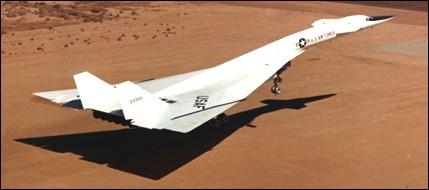 |
North American XB-70 Valkyrie1964 |  |
| BOMBER | Virtual Aircraft Museum / USA / North American |
 |
Developed to USAF General Operational Requirement 38 for an intercontinental bomber to replace the Boeing B-52, the Mach 3 North American XB-70A was the subject of an order for three prototypes, awarded on 4 October 1961, although the third was later cancelled. A delta-winged canard design, with wing tips which folded down at 65° to the horizontal to provide improved supersonic stability, and powered by six 13608kg thrust General Electric J93-GE-3 engines, the first prototype was flown by Alvin S. White and Colonel Joseph F. Cotton on 21 September 1964; it first achieved its design speed of Mach 3 on 14 October 1965. The improved second prototype flew on 17 July 1965, but was lost in a mid-air collision on 8 June 1966. The surviving aircraft carried out a number of test programmes, including work in connection with the US supersonic transport programme, but on 4 February 1969 it was flown to retirement at the US Air Force Museum, Wright Patterson AFB, Dayton, Ohio. FACTS AND FIGURES © The Valkyrie's wingtips lowered to trap the shockwave under the fuselage and create 'compression lift', allowing operation at nearly 24,320m. © Company brochures claimed a B-70 could take off from the western US and intercept Chinese invaders approaching Taiwan before they were halfway across. The Valkyrie was not an interceptor, nor had it any anti-shipping capability. © The crew's seats became enclosed in individual escape capsules in an emergency. In the XB-70 crash, only one capsule functioned correctly. © Most of the XB-70 was made of a new type of stainless steel. The different grades of metal used caused electrolytic corrosion. North American XB-70 Valkyrie on YOUTUBE
|  COMPANY PROFILE | ||||||||||||||||||||||||||||||||||||||||||||||||
 |

|

